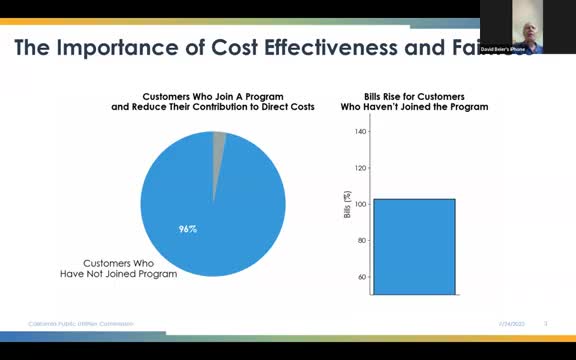California CPUC Focuses on Equity in Ratepayer Funding for Social Programs
July 26, 2025 | Little Hoover Commission, Other State Agencies, Executive, California
This article was created by AI summarizing key points discussed. AI makes mistakes, so for full details and context, please refer to the video of the full meeting. Please report any errors so we can fix them. Report an error »

The Little Hoover Commission convened on July 24, 2025, to discuss critical issues surrounding California's electricity costs, focusing on the implications of cross-subsidies and the equity of funding public policy programs. The meeting highlighted the financial burdens placed on ratepayers due to various social programs, including low-income subsidies, green energy initiatives, wildfire mitigation measures, and solar energy incentives.
The discussion began with a request for clarity on how these programs are funded and whether it would be more equitable to finance them through taxpayer money rather than through ratepayer systems. The California Public Utilities Commission (CPUC) was asked to address the equity of these funding mechanisms, particularly in light of the regressive nature of costs associated with ratepayer funding.
A representative from the CPUC presented data illustrating the contributions of different programs to electricity rates. The analysis revealed that rooftop solar tariffs and the California Alternate Rates for Energy (CARE) program significantly impact rates, with rooftop solar causing a larger cost shift compared to low-income programs. The CPUC emphasized the importance of understanding these cost shifts to make informed decisions about future actions aimed at reducing customer costs.
The CPUC acknowledged the ongoing challenge of addressing the cost shifts associated with net energy metering (NEM) programs, which allow customers with solar panels to offset their energy use. While changes were made in 2022 to mitigate these shifts, many customers remain on older tariffs, perpetuating the issue.
Commissioners raised questions about the absence of a dedicated line item in the state budget for rate discounts, which could alleviate some of the financial pressure on low-income customers. Currently, the CARE program provides discounts of up to 35% to approximately 4 million Californians, but funding for such programs primarily comes from utility rates rather than general fund allocations.
The meeting concluded with a consensus on the need for further evaluation of funding sources for these programs. The CPUC expressed a commitment to exploring non-ratepayer funding options, including potential contributions from the general fund and other state resources, to enhance equity in funding public policy goals.
Overall, the discussions underscored the complexities of California's electricity cost structure and the ongoing efforts to balance the financial responsibilities of ratepayers with the need for equitable access to energy programs. The CPUC plans to continue its analysis and engage with stakeholders to address these pressing issues in future meetings.
The discussion began with a request for clarity on how these programs are funded and whether it would be more equitable to finance them through taxpayer money rather than through ratepayer systems. The California Public Utilities Commission (CPUC) was asked to address the equity of these funding mechanisms, particularly in light of the regressive nature of costs associated with ratepayer funding.
A representative from the CPUC presented data illustrating the contributions of different programs to electricity rates. The analysis revealed that rooftop solar tariffs and the California Alternate Rates for Energy (CARE) program significantly impact rates, with rooftop solar causing a larger cost shift compared to low-income programs. The CPUC emphasized the importance of understanding these cost shifts to make informed decisions about future actions aimed at reducing customer costs.
The CPUC acknowledged the ongoing challenge of addressing the cost shifts associated with net energy metering (NEM) programs, which allow customers with solar panels to offset their energy use. While changes were made in 2022 to mitigate these shifts, many customers remain on older tariffs, perpetuating the issue.
Commissioners raised questions about the absence of a dedicated line item in the state budget for rate discounts, which could alleviate some of the financial pressure on low-income customers. Currently, the CARE program provides discounts of up to 35% to approximately 4 million Californians, but funding for such programs primarily comes from utility rates rather than general fund allocations.
The meeting concluded with a consensus on the need for further evaluation of funding sources for these programs. The CPUC expressed a commitment to exploring non-ratepayer funding options, including potential contributions from the general fund and other state resources, to enhance equity in funding public policy goals.
Overall, the discussions underscored the complexities of California's electricity cost structure and the ongoing efforts to balance the financial responsibilities of ratepayers with the need for equitable access to energy programs. The CPUC plans to continue its analysis and engage with stakeholders to address these pressing issues in future meetings.
View full meeting
This article is based on a recent meeting—watch the full video and explore the complete transcript for deeper insights into the discussion.
View full meeting
